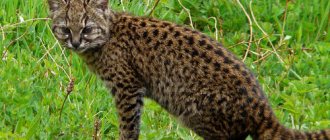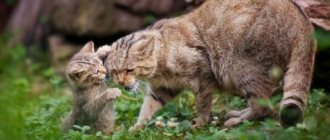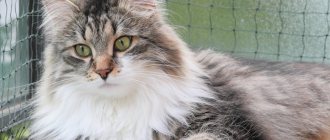Among the numerous species of cats, only the lynx is found in the northern regions. Human activity has contributed to the partial, and in some places, complete disappearance of this representative of the animal kingdom in Europe. Today you can meet a lynx only in some countries; this wild animal is protected by law in many of them. The Siberian lynx species is common in Russia, the description of which we will discuss in this article.
Where does the lynx live?
This animal can be found in European countries, and the lynx can also be seen in China, Georgia and Greece. More than half of the representatives of this species live on the western continents, in the United States of America and Canada.
On the territory of the Russian Federation, the animal can be seen in taiga forests. Depending on the habitat, both the physical and external characteristics of the animal differ.
Reproduction
The bobcat has a polygynous breeding system, meaning males can have relationships with multiple females in their lifetime. The gestation period of the offspring is a little more than 2 months, the eyes of small lynx cubs open on the 10th - 11th day of life, and the female feeds them with her milk for 60 days. After this, for six months, the mothers of the cubs teach them everything they will need to survive independently. In some species, both males and females participate in raising offspring; some species of this animal differ in that only the mother raises the cubs. Female red lynx become sexually mature after a year of life, males - after 2 years.
Predator Paws
The lynx is endowed with long limbs with wide, powerful paws. The prints of the front feet are round in shape, the hind ones are elongated and more oval. The diameter of the front paw prints of an adult animal in summer is approximately 7.7x7.9 cm. In winter, the animal’s feet become heavily overgrown with long hair, which covers the entire surface of the sole and increases its print on the snow at least twice - up to 16-17 cm in diameter , and sometimes up to 23 cm. The size of the footprint of the hind legs in the warm season is 7x9 cm.
The predator has four toes on its hind limbs and five on its front limbs. The fifth, thumb, is very shortened, not opposed to the others and is placed higher, so it does not leave an imprint when walking. Lynxes are digitally walking animals; their voluminous toe pads and metatarsal pads evenly distribute the mass of the predator over the entire foot.
Types of lynx
The lynx, like any representative of the cat, is an excellent tree climber. She feels much more comfortable on the branches than on the ground. Experts explain this by the structural features of the lynx.
European
The European lynx is comparable in size to a large dog. The tail has a chopped end, the body itself is dense. The European lynx has large, long legs, which allows it to easily climb trees.
Swamp Lynx
The jungle cat, or in other words, the swamp lynx, has its own distinctive features. This species of cat is extremely rare, its numbers are becoming smaller and smaller every year. For this reason, it was listed in the Red Book. The main reason for the decline in the population is the peculiarity of where this lynx lives. The cold winter months lead to a decrease in population and extinction of the species.
Their weight depends on the sex of the animal, the weight range is quite large, a lynx can weigh from 4 to 17 kilograms.
This breed of cat develops good speed in thickets and also jumps high. This is explained by strong powerful paws. It is extremely rare to see a swamp lynx in the wild. Another feature of this animal is that they have excellent vision at night.
Spanish
The Spanish lynx has many names, Iberian, Iberian and others. Many are concerned about the question of where a representative of this breed lives. Currently, most of these animals are located in the national park; initially, the Iberian lynx could be found in the forests and mountains of Portugal and Spain. The Spanish lynx was once one of the subspecies of the Eurasian lynx. However, experts have found that these two representatives of the cat family evolved separately.
The Spanish lynx is known for its fur becoming thinner during the winter months. Its dimensions are not the largest, height is about 50 centimeters, length 80 – 90 cm. The mass of the Spanish lynx lies in the range of 12 – 22 kilograms.
The Perenean lynx has fur of a brown or yellow hue, the spots can be of very different shapes and sizes. One of their main features is that the jaw is longer than that of other representatives of this class, and the muzzle is quite narrow. These structural features allow the Perenean lynx to make powerful bites; the victim dies in a maximum of 2 - 3.
Red
Another representative of the cat family is the red lynx. It is also called red or orange. Currently, the red lynx lives in North America. If we compare the sizes of a domestic lynx and a red one, the second will be approximately 2 times larger. The red lynx's body can be up to 110 centimeters in length, not including the 10 - 20 centimeter tail. Weight is about 10 kilograms. A distinctive feature of the red lynx is its long and large paws; a red lynx can be recognized by the whiskers on its face.
The bobcat has a variety of habitats and can be found in subtropical forests, hot deserts, wetlands and mountains. In some cases, bobcats can be found even in the suburbs. In case of any threat, this animal climbs a tree, where it feels very comfortable. The red lynx prefers to live where there is as little snow as possible. This is explained by the fact that its paws are not adapted to move on snowy terrain.
Siberian
Despite the large number of cat species, only the Siberian lynx can be found in the northern regions of the Russian Federation. Human activities in these regions have greatly affected the Siberian lynx population.
The wool of the Siberian lynx is highly valued on the market, which has also led to the fact that this representative of the cat breed is currently in the Red Book. The Siberian lynx has a unique structure that allows it to survive in cold climates. In addition to the fact that the animal is excellent at climbing trees, it also runs fast, swims well, and jumps high and far. Most often, the animal is found in coniferous forests, but their representatives can be found in forest steppes. Some have met lynxes in the Arctic Circle.
Desert
The desert lynx is understood as a wild representative of the cat family; another name for this animal is caracal. Translated from Turkish, the name of this animal means black ear.
The best chance of meeting a caracal live in the wild is in desert areas; the animal is often found in Africa and Asia Minor. Currently, there are about 9 subspecies of the desert lynx.
This type of cat has a relatively thin body no more than 85 centimeters long. Another characteristic feature of the caracal is its high ears, which are positioned vertically. The hard hair allows the animal to easily move through the sand mixture. Many people are concerned about the question of how much a lynx weighs; this breed weighs on average 12 kilograms. Males weigh slightly more than females.
[edit] Distribution
Among the cat family, common lynxes are the only ones that live far in the north, and according to some factual data, individuals of this species were found even in the Arctic. Due to the destruction of forests on the plains, the southern border of the range has shifted 200-300 km to the north over the past few decades.
The lynx lives in most of Eurasia. Previously, it was widespread in Europe, but by the middle of the 20th century it was almost completely exterminated in this territory.
Now the European lynx population numbers about 10 thousand individuals. As a rule, lynx prefers dark coniferous forests. However, it also lives in mountain forests, forest-steppe and forest-tundra. In recent years, it has been actively populating the Chernobyl zone.
Keeping at home
The lynx is an unusually beautiful animal, and some people do not refuse to have such an animal at home. The animal has wonderful grace and habits that make it possible to admire this representative of the cat family for hours. However, before you get a pet lynx, you should get to know them better.
In wild habitats it is extremely rare to encounter a representative of this species. Its main activity occurs at night or in the evening, but in spring the caracal often walks during the day. Also, the animal sometimes shows daytime activity in the winter months, which is explained by a lack of food. For this reason, the animal spends time intended for rest searching for food.
The home of this animal appears to be a crevice in the rock, but the caracal can settle in empty holes that, for some reason, were abandoned by a fox or other animal.
This representative of the cat breed very rarely remains hungry, this is explained by his innate talents for hunting. A powerful body and excellent hearing allow this animal to overtake its prey without much difficulty. A caracal can easily catch a bird from a flock that was about to take off. The lynx eats only animals or birds. This includes antelope, fox and even ostrich.
Many fans of this animal are interested in the question of how much a lynx costs. Its cost can be compared with the cost of a foreign car or a new domestic car. This is explained by the small number of caracals. In the vastness of the global network there are various prices, which range from 450 thousand to 1 million rubles.
Previously, lynxes were kept indoors so that the predator would help them protect the territory. It is possible to keep such an animal in an apartment, but in order to do so you will have to make some sacrifices. The tray should be significantly larger than that of domestic cats. The caracal needs to be trained; it is recommended to immediately teach it to relieve itself while walking. This animal needs fresh air every day, just like dogs. If you follow all the rules for training an animal, your furniture and home will remain safe and sound.
Vision
Nature has endowed the wild cat with very sharp vision, the ability to clearly focus on a moving object during the chase and maneuvering. The lynx's eyes are designed in such a way that they are able to capture the slightest rays of light reflected from objects. This allows the animal to hunt during the twilight hours - at dawn and before nightfall. But at the same time they do not perceive ultraviolet and infrared radiation ranges.
The shape of a lynx's eye is round, elliptical, with sharp outer corners. The color of the iris is mostly sand-colored, but some representatives of the caracal species have blue eyes. The animal's pupils are slightly oval, have a vertical position, and at night they dilate and become round, thereby regulating the supply of light. In complete darkness, a wild cat cannot see, but has excellent orientation thanks to the vibrissae - highly sensitive long hairs on the face and ears that detect the slightest sound vibrations.
Enemies in the wild
The main danger to the lynx is humans. The fur of this animal is very valuable in the market, and this animal can also attack livestock. When an animal meets a man, he tries to hide from him in a tree. Very rarely, the lynx was the first to attack a person. If the animal was wounded, it will not run away; the animal tries to jump on the hunter and kill him.
Another danger for this animal is wolves. If the lynx is young, it does not climb a tree, but tries to run away from the pack, which always ends in the death of the feline. An experienced animal will sit on a tree until the flock stops besieging it.
Hunting
The lynx goes hunting in the dark. This fact completely destroys the myth that it jumps from a tree onto its prey. Tries to get as close to prey as possible, often trying to hide near a fallen tree or in dense bushes.
Choosing the most appropriate moment, usually this is a distance of 10 - 15 meters and instantly attacks, making jumps from 3 to 5 meters. Once caught in the paws and teeth of a predator, the prey dies within a few seconds.
Razor-sharp teeth and claws tear arteries in the neck and flesh of the animal, leaving no chance of salvation. Having eaten enough, she hides the remaining food in the snow or under small tree branches. A less fortunate hunter likes to follow the lynx - the wolverine, who is not averse to feasting on the remains of the prey.
If larger prey is being hunted, a surprise may await the wild cat. When it attacks a sika deer, it is able to drag a lynx on itself for several meters; sometimes the victim manages to escape from the tenacious clutches of the predator. But if you trust the statistics, in most cases, the cat kills its victim after some time.
Living conditions in the zoo
The lynx is a popular animal, due to its beauty. Many people visit the zoo because of their interest not only in elephants and tigers, but also in lynxes, among others. However, even in such conditions it is problematic to see it. The animal prefers to spend daytime in a niche; they mostly come out only in the early evening. They treat people indifferently and do not show any warm feelings towards the zoo workers. This animal will be much more interested in a sparrow that accidentally flies into the enclosure. The feline loves birds; for birds to fly into a lynx's enclosure is a mortal danger. Female animals like to play, like any other cats, with round objects, in this case pumpkins. Males are more cold-blooded in this regard and practically do not play.
Nutrition
The lynx's diet is very varied; it can consist of both rodents and artiodactyls. More often she likes to catch and eat different types of birds that live within her place of residence. In search of food, she can walk more than thirty kilometers a day.
In harsh winters, the animal can go to the outskirts of its property and attack domestic dogs and cats. I suggest you study the menu of the wild beast in detail. The most favorite food for this type of cat is: white hare, as well as:
- Roe deer;
- Musk deer;
- Bad deer;
- Foxes;
- Partridges;
- Raccoon dogs;
- Grouse;
- Beavers;
- Young wild boars;
This list does not include all the animals that our heroine can eat.
The animal eats little; one caught hare can last it for 3-4 days. For a lactating female, this food is enough for one meal. A caught large artiodactyl animal can feed a single individual for more than 1.5 weeks.
Usually, some predatory animals, being well-fed, do not hunt until the main supply of food runs out, but during this period a lynx can unnecessarily kill a fox or marten. This is probably due to the fact that she sees these animals as obvious competitors. Since their diet is very similar.
The lynx animal performs one of the most important tasks of exterminating weak and sick animals, preventing them from infecting healthy generations.











